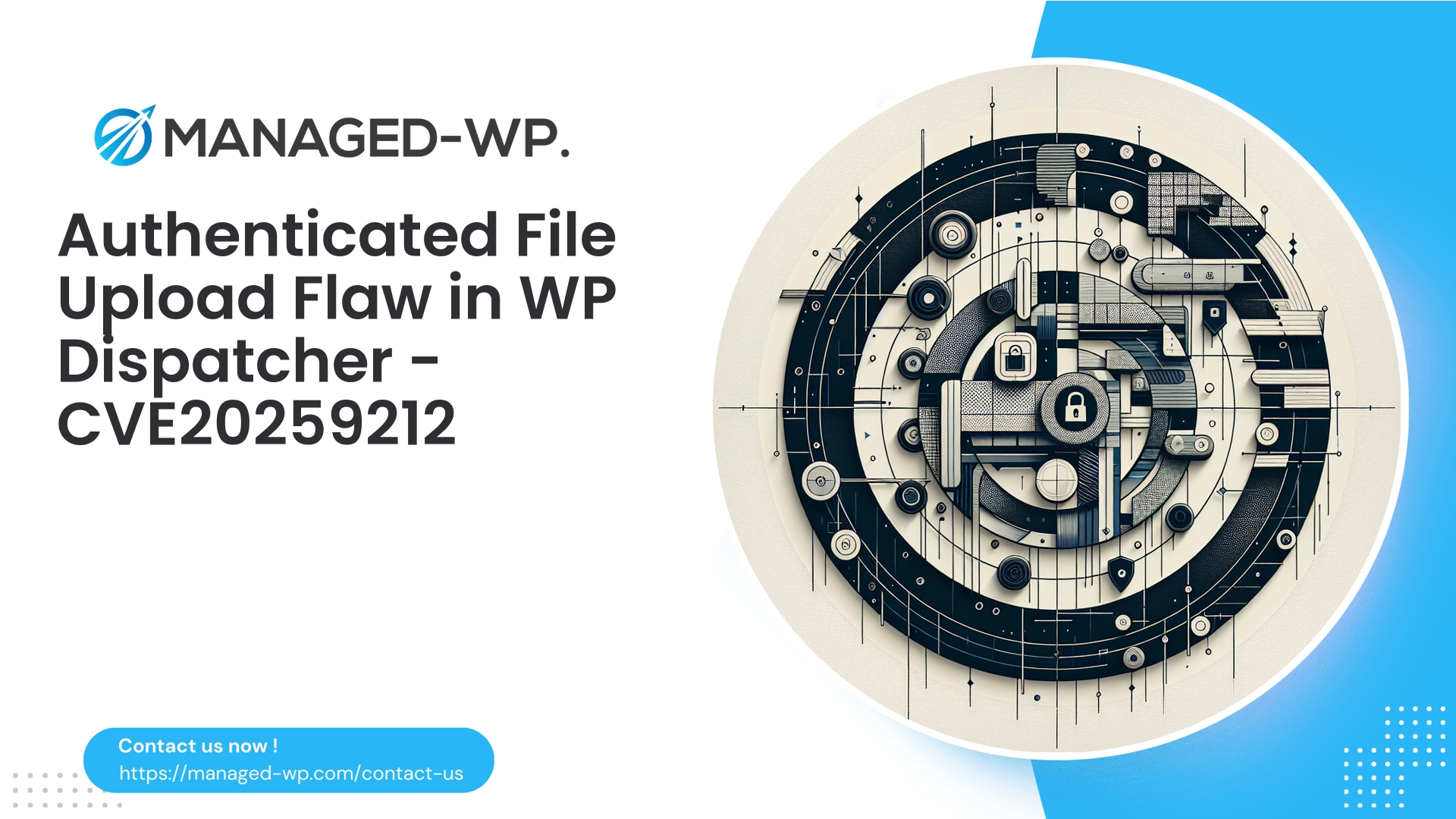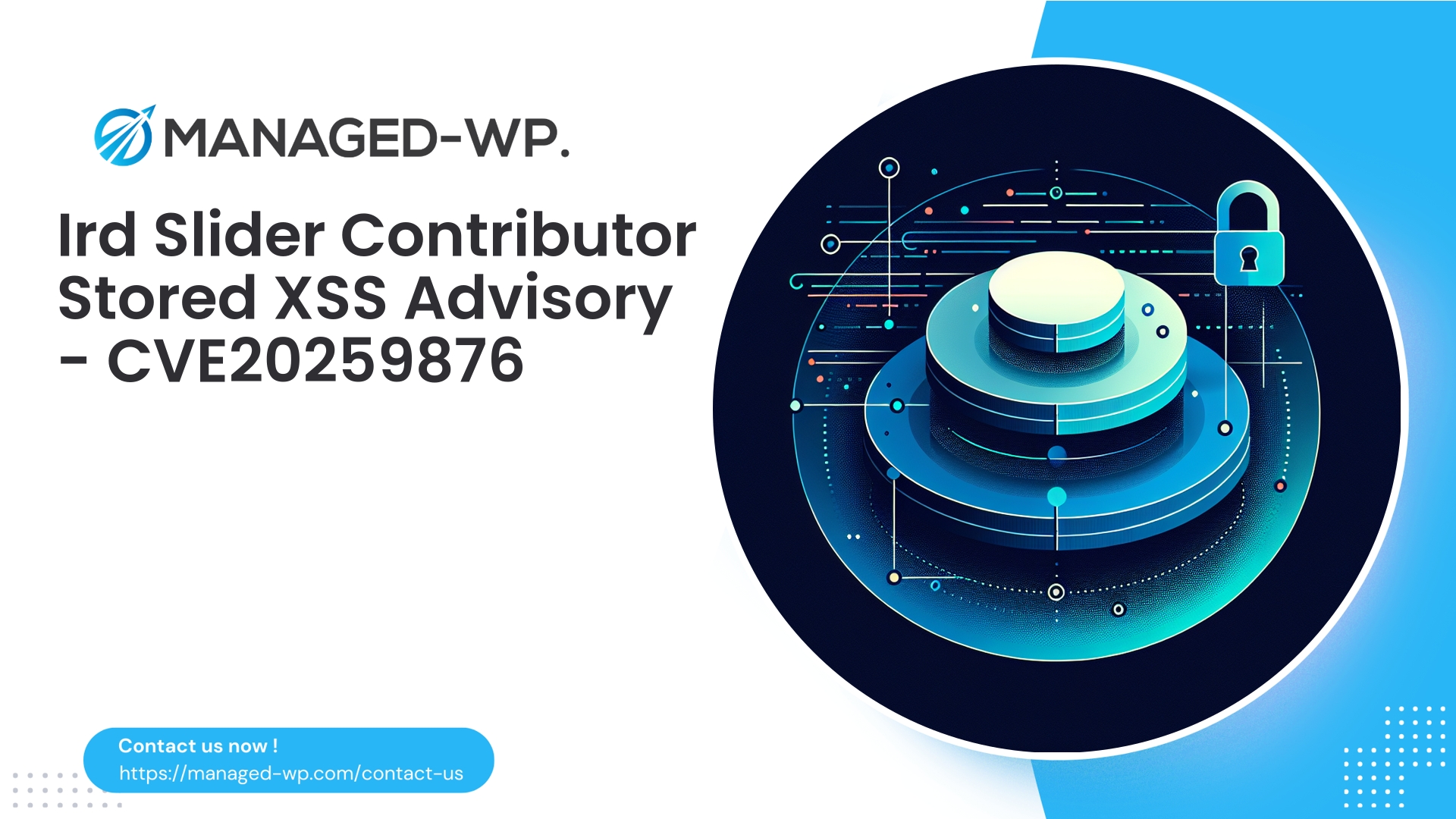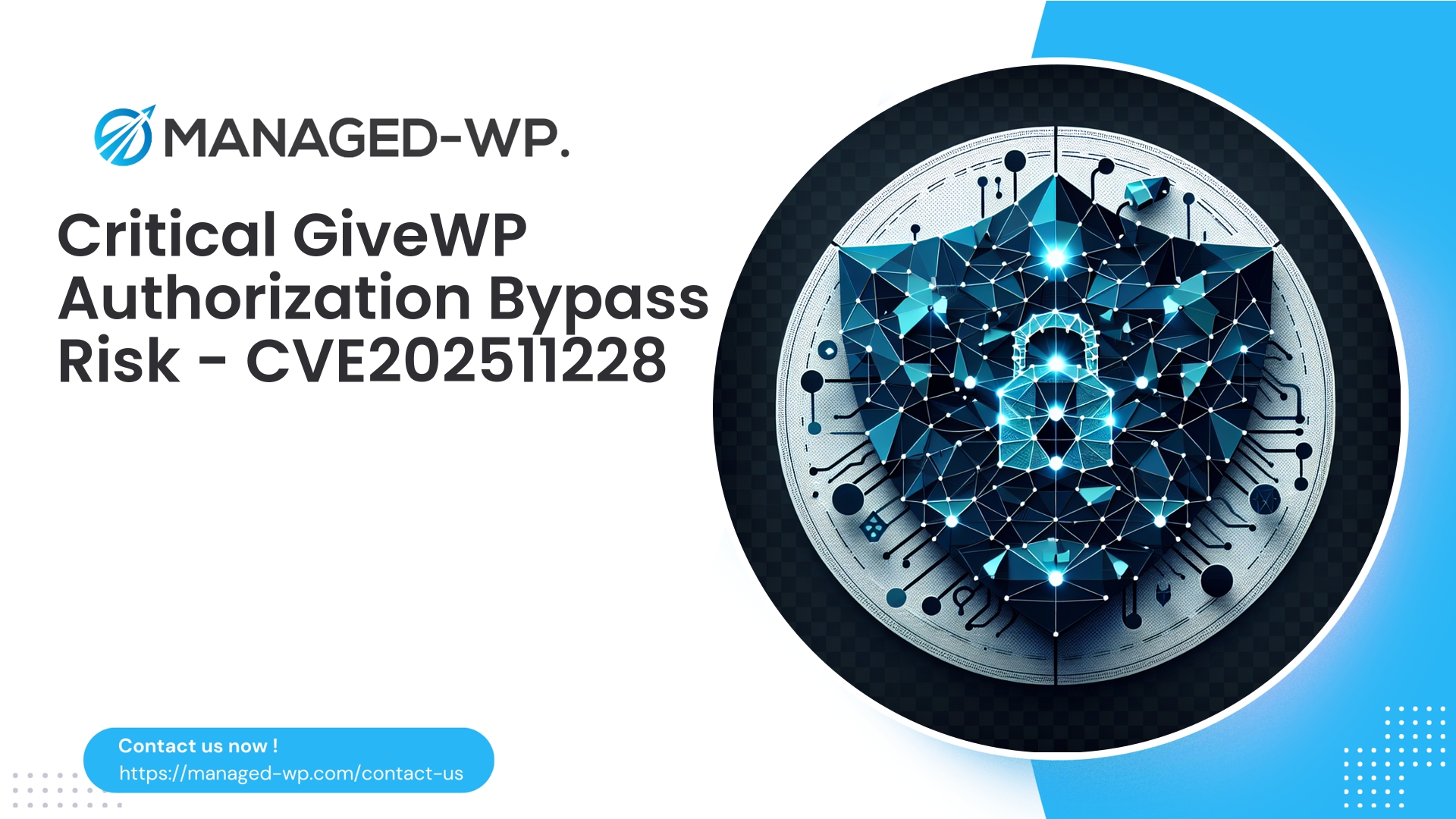| 插件名稱 | WP Dispatcher |
|---|---|
| 漏洞類型 | 任意文件上傳 |
| CVE編號 | CVE-2025-9212 |
| 緊急 | 高的 |
| CVE 發布日期 | 2025-10-03 |
| 來源網址 | CVE-2025-9212 |
緊急安全公告 — CVE-2025-9212:WP Dispatcher 外掛程式(≤ 1.2.0)中存在經認證的任意檔案上傳漏洞
發布日期: 2025年10月3日
嚴重程度: 高(CVSS評分9.9)
受影響版本: WP Dispatcher 版本 1.2.0 以下
報道人: 克雷格韋伯
作為一家總部位於美國的領先 WordPress 安全公司,Managed-WP 特此發布一項重要安全公告,提醒用戶注意 WP Dispatcher 外掛程式中新揭露的高風險漏洞。該漏洞允許擁有訂閱者角色(權限極低)的已認證使用者向您的 WordPress 網站上傳任意檔案。利用此漏洞可能導致遠端程式碼執行、持久性 Webshell 安裝以及網站完全接管。
本文從專家角度分析了該漏洞、實際利用場景、檢測策略、用於降低當前風險的實用 WAF 規則、逐步修復指南以及專門為 WordPress 網站管理員量身定制的長期加固措施。
執行摘要
- 漏洞: 允許訂閱用戶繞過安全控制的任意檔案上傳(需經過驗證)。
- 潛在影響: 透過遠端程式碼執行、持久後門和資料外洩實現網站完全入侵。
- 補丁狀態: 截至本文披露之時,尚未發布官方插件補丁。
- 立即採取的行動: 停用或卸載存在漏洞的插件;套用基於 WAF 的虛擬修補程式;在上傳目錄中強制執行 PHP 執行限制;審核是否有入侵跡象;並在必要時輪換所有憑證。
- Managed-WP 推薦: 部署我們託管的防火牆規則,提供虛擬修補功能,以阻止攻擊嘗試,直到插件作者發布官方修復。
為什麼這種漏洞特別危險
任意文件上傳漏洞是 WordPress 網站面臨的最嚴重的安全風險之一,因為它們能夠有效繞過關鍵的安全防線。攻擊者一旦成功將惡意 PHP 程式碼上傳到可透過 Web 存取的目錄,即可執行任意命令、建立持久化感染、竊取數據,並進而攻擊其他系統。
這種漏洞會因以下幾個因素而加劇風險:
- 僅需具有訂閱者角色的身份驗證存取權限-該角色通常對網站註冊使用者或評論者開放。
- 目前還沒有官方的插件補丁可用,網站仍然存在安全隱患。
- 利用該漏洞簡單、可重複且可擴展,攻擊者可以針對多個網站進行攻擊。
- 該插件的核心功能是接收文件數據,這為文件上傳濫用提供了一個天然的入口點。
由於其易於被利用且可能造成嚴重影響,迅速採取緩解措施勢在必行。
技術背景:任意文件上傳漏洞是如何產生的
了解常見原因有助於管理員審核程式碼庫並實施緩解措施。典型缺陷包括:
- 權限檢查不足-未能驗證目前使用者是否具有上傳權限,例如,缺少上傳權限。
current_user_can('upload_files')確認。 - 缺少 nonce 驗證-未能確認請求來自合法來源。
- 檔案驗證薄弱-僅進行用戶端副檔名檢查,而沒有進行伺服器端 MIME 類型驗證或內容檢查。
- 檔案名稱清理不當-允許檔案名稱具有多個副檔名或遍歷目錄。
- 直接將上傳檔案儲存到網站根目錄,而不停用 PHP 執行。
- 盲目信任HTTP標頭,例如
內容類型.
WP Dispatcher 中的證據表明,缺少功能檢查和伺服器端驗證不足,導致訂閱用戶可以上傳任意檔案。
真實的漏洞利用場景
- 以訂閱者身分上傳後門 PHP Webshell:
- 惡意行為者創建或入侵了使用者帳戶。
- 他們上傳了一個名為
avatar.php.jpg包含 PHP webshell 程式碼。 - 如果伺服器允許執行此類文件,攻擊者即可遠端執行任意命令。
- 透過持久後門控制網站:
- 上傳後,攻擊者會建立新的管理員使用者、安裝惡意插件,或向主題檔案注入後門。
- 調度程序條目或資料庫後門會在初始存取後仍然存在。
- 憑證被竊取,導致系統完全被接管,資料外洩。
- 大規模剝削:
- 攻擊者掃描 WP Dispatcher ≤ 1.2.0 的安裝,並自動將檔案上傳到多個網站。
- 成功的自動化攻擊會造成大範圍的破壞。
鑑於這些傳播途徑,立即採取遏制措施至關重要。
入侵指標(IoC)
注意這些不易察覺但卻能說明問題的剝削跡象:
- 出乎意料
.php,.phtml,.phar,.php5或類似文件wp-content/uploads/或其他可透過網路存取的資料夾。 - 具有可疑雙副檔名的文件,例如:
image.jpg.php. - 新增或修改管理員帳戶,或變更使用者元資料。
- 與後門相關的異常規劃任務或定時任務。
- 主題或外掛程式檔案的更改,尤其是頁首/頁尾或
函數.php. - 伺服器出現意外的出站流量或網路連線。
- 訪問日誌顯示來自訂閱者帳戶的帶有上傳負載的 POST 請求到插件端點。
- CPU或其他資源使用率出現無法解釋的峰值,這與webshell活動一致。
如果懷疑有安全漏洞,則應將日誌保存在不可篡改的儲存媒體中以備調查。
檢測策略:日誌和遙測
管理員應監控以下可疑活動模式:
- 來自訂閱者層級帳戶的 POST 請求,目標為外掛程式上傳端點,例如
admin-ajax.php. - 請求與
Content-Type: multipart/form-data包含可疑的檔案副檔名。 - 包含 PHP 程式碼片段的有效載荷
<?php在上傳提交內容中。 - 請求
/wp-content/uploads/以前不可用的資源或返回 404。 - 異常的用戶代理字串可能表示存在自動掃描器(請注意攻擊者可以偽造此字串)。
- 建立或修改管理員使用者的新資料庫條目。
設定警報,以便及時偵測可疑文件上傳和異常使用者行為。
立即採取的緩解措施
- 如果條件允許,請將您的網站置於維護模式,以避免修復過程中出現風險。
- 請從所有受影響的環境中停用並移除 WP Dispatcher 外掛程式。如果無法立即移除,請在防火牆中封鎖該外掛程式特定的 HTTP 端點。
- 透過配置禁用上傳目錄中的 PHP 執行
.htaccess或您的 Nginx 伺服器設定。 - 對上傳資料夾和網站根目錄進行徹底掃描,以識別和隔離可疑檔案。
- 如果出現安全漏洞跡象,請輪替所有管理和服務憑證(WordPress、FTP、SSH、資料庫)。
- 撤銷並重新產生 WordPress 安全金鑰和鹽值
wp-config.php文件。 - 審核 WordPress 用戶,刪除或鎖定任何異常或可疑的帳戶。
- 如果確認系統已被入侵且後門無法清除,請從乾淨的備份中還原您的網站。
- 透過 WAF 規則部署虛擬補丁,以阻止漏洞利用嘗試,直到官方插件更新可用。
如果您有任何疑問或發現正在發生的安全漏洞跡象,請立即聯絡專業的事件回應專家。
修復程式碼片段
1) 使用 Apache (.htaccess) 阻止在上傳目錄中執行 PHP 程式碼:
# 禁止執行上傳資料夾中的腳本否認一切安全規則引擎開啟# 停用腳本執行處理程序 RemoveHandler .php .phtml .php5 .phar
2) Nginx 伺服器阻止 PHP 上傳:
location ~* /wp-content/uploads/.*\.(php|phtml|php5|phar)$ { deny all; access_log off; log_not_found off; return 403; }
3)臨時 WordPress 過濾器,用於阻止訂閱者上傳內容(僅限緊急情況使用):
角色)){$file['error'] = '由於安全性問題,您的帳號等級暫時停用上傳功能。 ';}}return $file;}
注意:在完成修復和修補部署後,請移除此篩選器。
虛擬補丁/WAF 規則範例
以下是一些可立即部署的 ModSecurity 風格規則範例,用於阻止漏洞嘗試。請根據您的環境進行調整並仔細測試,以避免誤報。
阻止包含 PHP 程式碼的多部分上傳:
# 阻止多部分上傳中的 PHP 程式碼 SecRule REQUEST_HEADERS:Content-Type "multipart/form-data" "phase:2,t:none,chain,deny,status:403,msg:'阻止包含 PHP 內容的上傳'" Secule MULTIPART_STRn_SY"P&PxS;SY;
阻止上傳可執行檔類型:
SecRule FILES_TMPNAMES "@rx \.(php|phtml|php5|phar)$" "phase:2,deny,status:403,msg:'可執行檔案上傳被封鎖'"
阻止可疑的雙副檔名:
SecRule ARGS_NAMES|ARGS "@rx \.(php|phtml|php5|phar)$" "phase:2,deny,status:403,msg:'檔案名稱包含不允許的副檔名'"
阻止向已知用於上傳的插件端點發送 POST 請求:(範例)
# 阻止可疑外掛程式上傳 SecRule REQUEST_URI "@beginsWith /wp-admin/admin-ajax.php" "phase:1,chain,deny,status:403,msg:'阻止可疑的 admin-ajax 上傳'" Secule ARGSGS:action"@r( "t:none"
先進的: 如果您的 WAF 支援 WordPress 集成,則可以根據 cookie 或會話追蹤阻止訂閱者角色上傳檔案。
長期加固建議
- 應用最小權限原則:限制權限,使訂閱者無法上傳檔案。
- 如非必要,請停用或嚴格控制用戶註冊。
- 實施嚴格的密碼策略,並對管理者強制執行多因素身份驗證(MFA)。
- 永久阻止 PHP 在上傳目錄中執行。
- 在伺服器端限制允許的檔案類型,除了驗證檔案副檔名外,還驗證 MIME 類型和檔案頭。
- 上傳檔案時請使用防毒和惡意軟體掃描功能。
- 請確保 WordPress 核心程式、主題和外掛程式已安裝最新的安全性修補程式。
- 定期審核並移除無人維護或不必要的插件。
- 定期輪換安全金鑰和鹽,並在任何疑似安全漏洞出現後進行輪調。
- 使用基於金鑰的 SSH 身份驗證來限制伺服器級訪問,並停用密碼登入。
- 將測試環境和生產環境隔離,以最大限度地降低風險。
事件回應檢查表
- 啟用維護模式或限制外部訪問,隔離受影響的網站。
- 建立並安全地儲存目前系統備份,以進行取證分析。
- 保留所有相關日誌(Web 伺服器、PHP、資料庫、系統日誌)。
- 掃描檔案系統,尋找 webshell 和不明文件;隔離並分析可疑文件。
- 審核資料庫是否有未經授權的更改,包括新增使用者或修改貼文。
- 輪換所有憑證和 WordPress 安全性金鑰。
- 從可信任來源重新安裝 WordPress 核心檔案、外掛和主題。
- 刪除所有未知或可疑的插件和檔案。
- 審核並重新發布所有 API 金鑰或第三方整合。
- 持續監測清理後是否出現再次感染或異常跡象。
- 完整記錄事件經過,並通知您的主機提供者或安全相關人員。
如果對補救措施的信心不足,請立即聘請專業的事故應變專家。
檢測模式與 SIEM 集成
- 收到新文件提醒
/wp-content/uploads/帶有可疑擴展名,例如php,phtml, 或者藥學. - 監控對插件相關端點的 POST 請求,這些請求的有效負載中包含 multipart 表單資料和 PHP 程式碼。
- 標記來自低權限角色(例如訂閱者)的上傳內容。
- 偵測突然建立的管理員等級帳戶。
- 追蹤日程安排或外掛程式相關資料庫條目的意外修改。
這些警報能夠及早發現攻擊企圖,並及時做出事件回應。
虛擬修補和託管規則的重要性
當官方插件修補程式不可用時,在 Web 應用防火牆 (WAF) 層進行虛擬修補是最快捷、最有效的風險降低方法。虛擬修補:
- 無需等待插件更新即可提供即時防禦。
- 以精細控制阻止已知的攻擊特徵和利用有效載荷。
- 同時降低所有託管網站的風險敞口。
Managed-WP 的虛擬修補程式服務部署經過測試和微調的規則集,並持續監控誤報,以最大限度地減少中斷。
執行 WP Dispatcher ≤ 1.2.0 的網站的關鍵檢查清單
- 從所有生產環境停用並解除安裝 WP Dispatcher。
- 確保在上傳資料夾中禁止執行 PHP 程式碼。
- 應用 WAF 規則可阻止上傳具有禁止副檔名或可疑的多部分有效負載的檔案。
- 對網站和伺服器資料進行全面的惡意軟體掃描。
- 審計日誌中是否有可疑行為,特別是訂閱者帳戶的 POST 請求。
- 刪除可疑文件,必要時恢復乾淨的備份。
- 輪換管理員密碼並更新 WordPress 安全鹽和金鑰。
- 持續進行主動監控,以偵測補救措施後的威脅。
如果由於營運限製而延遲移除插件,至少應確保透過防火牆阻止針對插件漏洞的 HTTP 請求。
推薦的開發者修復方案
插件開發者應實施以下安全措施:
- 嚴格執行權限檢查,確保只有授權使用者(例如,擁有以下權限的使用者)才能存取網路:
上傳文件具備上傳文件的能力。 - 驗證所有表單和 AJAX 上傳端點中的 nonce 值。
- 實現強大的伺服器端檔案類型驗證,包括 MIME 檢查和內容嗅探。
- 嚴格清理檔案名,不允許使用雙重副檔名或特殊字元。
- 盡可能將上傳檔案儲存在網站根目錄之外,並透過安全代理提供內容。
- 優先採用允許清單方法-只允許影像檔案或安全的媒體類型,而不是試圖阻止已知的有害類型。
任何與上傳相關的程式碼都應該附帶全面的單元測試和安全測試。
長期治理與安全衛生
- 維護所有已安裝插件及其版本的最新清單。
- 訂閱可信任的安全通知服務,以取得漏洞預警資訊。
- 在生產環境部署之前,先在測試環境中測試插件更新,優先處理安全性修補程式。
- 移除不再維護或不再必要的插件。
- 採用分層防禦策略,結合伺服器加固、WordPress 最佳實務、WAF 保護和持續監控。
使用 Managed-WP Basic(免費)保護您的 WordPress 網站
對於尋求快速、免費的基礎防禦方案的使用者而言,Managed-WP Basic 提供一系列關鍵安全功能,包括業界級 Web 應用防火牆 (WAF)、惡意軟體掃描以及針對 OWASP Top 10 威脅的防護。這項託管防火牆服務能夠有效緩解常見的攻擊途徑,例如任意文件上傳,同時您可以製定全面的緩解計劃或等待官方修補程式發布。
立即開始: https://my.wp-firewall.com/buy/wp-firewall-free-plan/
升級至標準版或專業版套餐,即可獲得自動惡意軟體清除、可設定的 IP 黑名單/白名單、高級虛擬修補程式、每月安全報告和專家管理支援——非常適合高風險環境。
常見問題解答
Q:我應該立即刪除 WP Dispatcher 外掛程式嗎?
答:如果可能,請徹底卸載該插件以消除安全漏洞。如果網站正常運作至關重要,請先停用該插件,並在防火牆中封鎖其所有端點,直到可以完全移除為止。
Q:禁止所有上傳是否為可行的解決方案?
答:完全禁止上傳是一種簡單粗暴但有效的緊急措施。對於需要合法上傳功能(例如頭像)的網站,應實施基於角色的上傳限制和惡意軟體掃描,以達到平衡的安全防護。
Q:如果我懷疑我的網站已經透過這個漏洞被入侵了怎麼辦?
答:請遵循上述事件回應清單。 Webshell 存在和持久後門需要徹底清理、憑證輪換,並且可能需要從乾淨的備份中還原整個網站。
Q:Managed-WP虛擬補丁會影響我的網站效能嗎?
答:不。設計合理的 Web 應用防火牆規則能夠在網路邊緣高效運行,並將延遲或伺服器負載降至最低。 Managed-WP 可確保規則已最佳化,並持續監控其效能。
最後的想法
此漏洞凸顯了 WordPress 中安全文件上傳處理的重要性。訂閱用戶絕不能上傳可執行文件,這些文件可以在您的伺服器上運行。
必須立即採取行動:封鎖攻擊路徑,移除存在漏洞的插件,徹底掃描是否有入侵,並加強您未來的環境安全。我們的 Managed-WP Basic 服務可為您提供簡單有效的保護層,讓您有充足的時間規劃並實施全面的修復方案。
如果您在虛擬修補程式或事件回應方面需要專家指導,我們的安全團隊隨時準備協助您進行遏制和復原。



















